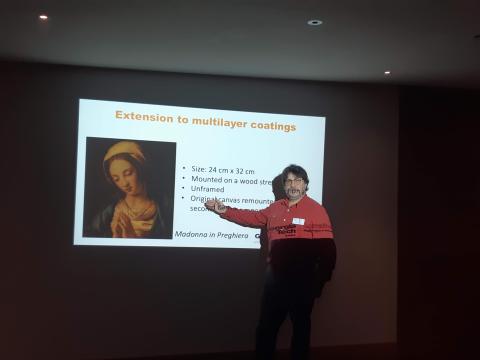Citrin’s seminar “Teasing out the hidden layers of an old master painting using terahertz imaging” presented research led by ECE graduate student Junliang Dong using terahertz imaging to measure for the first time multiple paint layers in a 17th century easel painting Madonna in Prayer by Italian painter Giovanni Battista Salvi da Sassoferatto.*
Professor David Citrin’s research on painting analysis made the news in 2017 by revolutionizing the analysis of priceless historical artifacts using modern characterization techniques. His team’s use of terahertz electromagnetic imaging to image artworks in three dimensions—not just what one sees on the exterior, but also inside, beneath the surface, allows for nondestructive analysis of multiple layers of medium. Terahertz waves penetrate many non-metallic materials, such as paints, textiles, ceramics, glass, and paper, and can provide details of the structure in three dimensions down to about 0.01 mm. Thus, this technique is of great interest to museum conservators and art historians, who welcomed Professor Citrin to lecture at the Center for Research and Restoration of Museums of France (C2RMF) located in the basement of the Palais du Louvre in Paris. The C2RMF is a national research laboratory focused on documentation, conservation, and restoration of art in France’s museums.
Citrin’s seminar “Teasing out the hidden layers of an old master painting using terahertz imaging” presented research led by ECE graduate student Junliang Dong using terahertz imaging to measure for the first time multiple paint layers in a 17th century easel painting Madonna in Prayer by Italian painter Giovanni Battista Salvi da Sassoferatto.* The painting, loaned by the Musée de la Cour d’Or in Metz, provided quite a challenge, as the paint layers measured are between 0.03 and 0.13 mm thick. In fact, the measurement was a minor part of the work; most of the effort was to tease out useful information from rather blurry data using advanced signal-processing techniques, applied here for the first time to this type of problem.
In addition to work on several paintings, Citrin’s group is looking at manuscript pages, cloisonné enamels, Gallo-Roman ceramics, and Romanesque lead objects (terahertz can see below an obscuring layer of corrosion with the aim to read hidden inscriptions). Ever since graduate school, where he explored doing his PhD research in archeometry (he did not), Citrin has sought ways to apply his laboratory’s capabilities to contribute to our knowledge and preservation of cultural heritage.
